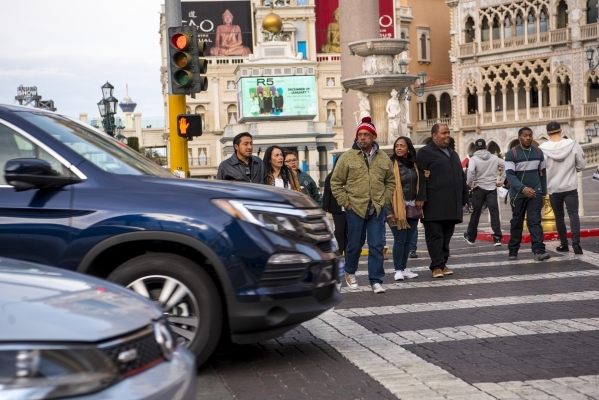Best solution for pedestrian deaths is to slow down

January was one of the bloodiest months in history for pedestrians in Southern Nevada.
The best solution for reducing the number of accidents that kill and maim people on the streets isn’t going to be very popular with motorists.
Slow down.
A lot.
In 2015, there were 61 pedestrian deaths in Southern Nevada. As of mid-February, there were 11 already, and six of them occurred in January.
It was a pretty sobering meeting of the Bus Shelter and Bench Advisory Committee of the Regional Transportation Commission where one of the regular presentations is to recap the number of bus shelters that have been obliterated since the last meeting and the circumstances behind the accidents. By the way, hours after the committee adjourned, one more pedestrian life was lost on the street.
Bus shelters were blasted Dec. 25, Dec. 28, Jan. 5, Jan. 9, Jan. 18, Jan. 23, Jan. 31, Feb. 1 and Feb. 4. You don’t hear about most of them in news stories unless someone is hurt.
Some of them were hit-and-run accidents and weren’t reported until someone later discovered the shelter had been smashed.
Erin Breen, who chairs the committee and is director of the Safe Community Partnership Program at UNLV’s Transportation Research Center, was beside herself at last week’s meeting.
“It all comes back to personal responsibility and people drive like there are no consequences,” she said at the meeting. “We, as a community, are not saying, ‘This is not acceptable.’ I’m sorry. This just makes me so angry.”
While Breen rightfully placed a lot of the blame on motorists — people driving drunk, people driving high, people driving distracted by their cellphones — it’s only fair to point out that pedestrians do a lot of dumb things, too.
Some of them don’t cross streets at crosswalks, assume that a motorist sees them, cross against the traffic light and wear dark clothing at night.
One would think they would have more sense than to take chances when the price for making the wrong decision is death. There’s simply no way an individual on foot is going to get the better end against 2 tons of steel going 50 miles an hour or faster.
The bus shelter and pedestrian safety issue isn’t anything new. In fact, there are community advocates all around who offer solutions to fortify bus shelters or to take them out of harm’s way.
One group has been talking for years about removing the screens on the back side of a bus shelter to give endangered customers a potential escape route if a car is on a collision course.
The RTC has determined that the best solution is to move shelters back away from the street. That would mean acquiring property from business owners. Often, a property owner will just give it over, but some companies have corporate policies that make such a transaction cumbersome.
Some bus stops are right up against a block wall. No moving back. No customer escape routes. RTC officials aren’t replacing shelters destroyed in accidents when they’re against a wall or there’s no right of way.
Other safety advocates have suggested fortifying bus stops with massive bollards or with innovative shelter designs. At last week’s meeting, a guy pitched the committee on a shelter called a Kat Guard. Innovative design, well-protected.
Local resident Rick Rosen has advocated a safety design developed by engineering professor Dean Sicking that is used to keep cars from the stands at the Las Vegas Motor Speedway.
There are several problems with fortifying bus shelters. The biggest ones are the expense, reaching decisions on which ones should be modified and whether the fortified shelters put motorists at increased risk.
There are some who believe every shelter should be modified. Considering there are 1,300 shelters in the valley, that is a massive capital outlay. Many of the proposed fixes would require drilling down 9 feet to anchor a surface structure. There is additional expense with that because there are utility lines beneath the surface to consider.
If you pick and choose some shelters to fortify, which ones do you do? There are no patterns indicating which locations are the riskiest.
If a shelter is sturdy enough to protect pedestrians, it becomes a roadside hazard that could kill a motorist in a collision. Engineers have developed solutions for roadside hazards, such as light poles, which snap off in a collision to avoid injuries to motorists. A lot of you are probably saying, “Who cares? It’s more important to protect the pedestrian.” Is it?
Then, there’s the “slow down” solution.
Carl Scarbrough, manager of advertising and transit amenities for the RTC, told me that nearly half of the valley’s bus stops are along streets that have speed limits of at least 45 mph. Knowing valley drivers the way we do, we’re talking about people traveling 55-60 mph on those streets.
And that’s why pedestrians don’t stand a chance.
So look for some future recommendations for lower speed limits and increased enforcement. That seems to be the best way to reduce the carnage.
It’s going to be a politically charged conversation, but one that needs to be had.
Something has to change.
Heavy traffic
Two substantially sized conventions might provide a few traffic tangles for motorists next weekend.
The ASD Market Week retail trade show at the Las Vegas Convention Center is expecting 50,000 to attend starting Sunday and running through March 2.
Meanwhile, the Healthcare Information and Management Systems Society sets up at The Venetian, Palazzo and Sands Expo Center on Feb. 29, running through March 4, with more than 30,000 people expected.
The combined shows will make rush hour a little busier along Paradise and Spring Mountain roads during opening and closing hours, around 9 a.m. and 5 p.m.
— Questions and comments should be sent to roadwarrior@reviewjournal.com. Please include your phone number. Follow the Road Warrior on Twitter @RJroadwarrior